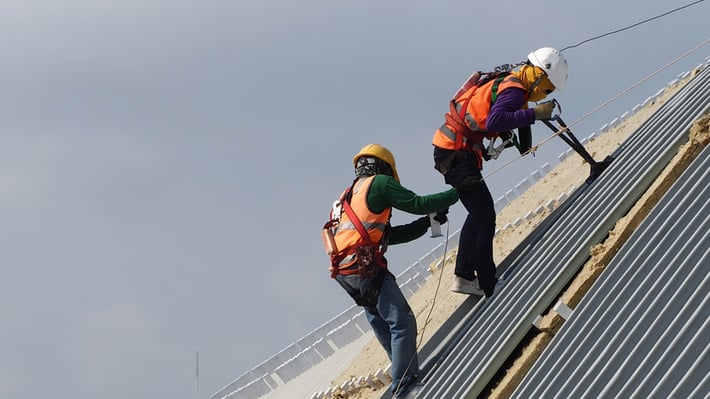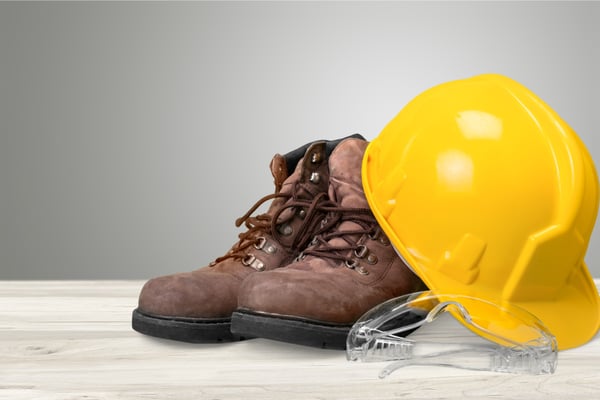Main Safety Hazards in Construction Sites

The construction industry represents approximately 20% of deaths in the private sector. Also, the fatal injury rate in construction is higher than the national average for all industries under the same category. Most accidents can be avoided with proper training and equipment, both sadly both factors are missing in many projects.
The responsibilities of construction managers also include accident prevention and workplace safety. This articles provides an overview of the main hazards in construction sites.
Make your project sites safer with our construction administration services.
Falls in Construction Sites
Construction often involves working at height, inside and outside of buildings. Working from roofs, scaffolds, ladders and stairways always comes with risks. Factors like harsh weather, equipment failure, negligence, and restricted mobility add to the possibility of falls. It is important for workers to be aware of risks: they must have personal protective equipment (PPE) and proper training to work at height.
Being Struck by Objects
Constructions are busy environments with constant movement from heavy duty equipment such as cranes and forklifts. Being struck by a moving object is a particular hazard on construction sites, it is important to have proper marking for hazard zones and appropriate barrier systems.
Electricity
The dangers of electricity are well known, but electrical hazards are not always obvious. All the project personnel is exposed, not only electricians. Some risk factors are overhead or underground cables, working close to power lines, lack of coordination, and using untrained workers for tasks that involve electricity. To avoid injuries it is important to know the exact location of all live conductors at the project site. The workforce must be qualified and well trained, and grounded tools must be provided.
Hazardous Materials
Many chemicals are used in construction sites, and plenty of them are toxic or respiratory irritants. Chemical spills can cause severe burns and release toxic fumes. Personal protective equipment and knowledge about the substances used can reduce the risk of accidents.
Repetitive Strain Injury and other Physical Ailments
About 64% of construction workers suffer from musculoskeletal disorders, as a result of an accident or through repetitive movement. Workers are also at risk from repeated use of particular machinery and equipment, such as ground working equipment and vibrating power tools, resulting in a condition called Hand Arm Vibration Syndrome or “blue finger”. This can cause the loss of many hours of work. Adequate training, protective gear, and proactive protocols can help prevent injuries.
OSHA Safety Series for Construction: Hazards and Solutions
The Occupational Safety and Health Administration provides a series of standards, covering possible hazards in construction and tips to prevent them.
Scaffolding
Hazard: When scaffolds are not assembled or used properly, falls are more likely. Protecting workers from scaffold-related accidents can help prevent approximately 4,500 injuries and 50 fatalities per year.
Solution:
- Scaffolds must be rigid and capable of handling their own weight, plus four times the maximum intended load. This must be without compromising stability, which means there must be zero settling or displacement.
- Scaffolds must be erected on solid footing. Barrels, boxes, bricks or blocks should not be used as scaffold supports. They must be equipped with guardrails, midrails and toeboards.
- Accessories such as braces, brackets, trusses, screw legs and ladders must be replaced or repaired when damaged.
- Supervision from a competent person is required for inspection and use of the scaffold.
- Employees must be informed about the adequate safety measures and guidelines for scaffolding.
Fall Protection

Hazard: Falls are the main cause of fatalities in the construction industry, and they can happen due to several factors. For example, unstable working surfaces, misuse of fall protection equipment and human error can all cause falls. Safety equipment such as nets and fall arrest systems can prevent many injuries and deaths.
Solutions:
- Aerial lifts and elevated platforms provide safer elevated working surface.
- Using safety net systems and body harnesses.
- Installing control line systems and guardrail systems with toeboards to prevent falling.
- Covering floor holes.
Ladders and Stairways
Hazard: Ladders and stairways used in construction account for approximately 24,882 injuries and 26 fatalities per year.
Solutions:
- There are many types of ladders, so make sure the right ladder is used for each task.
- Inspect ladders to check for structural damage, split or bent side rails, damaged steps or other accessories, grease or dirt that could cause slips, etc.
- Never exceed the maximum load capacity of a ladder.
- Avoid metal ladders near electrical work and overhead power lines.
- Stairway treads and walkways must be free of dangerous objects and slippery materials.
- Stairways with more than 30 inches must have at least one handrail.
Trenching
Hazard: Trench collapses causes dozen of fatalities and injuries per year.
Solutions:
- Never enter an unprotected trench.
- Use protective systems for trenches feet deep or greater.
- Providing an exit such as a ladder, stairway or ramp.
- Don’t place spoils within 2 feet from the edge of excavation.
- Inspecting trenches prior to entry and after hazard-increasing events such as a rainstorm.
- Trenches deeper than 20 feet must have a protective system designed by a registered professional engineer. The protective systems used are:
- Sloping the trench wall by cutting it at an angle inclined away from the excavation, following the requirements for the type of soil.
- Installing supports to prevent soil movements.
- Using trench boxes to prevent soil cave-ins.
Cranes
Hazard: Accidents can occur when workers are near an overhead load or within the crane swing radius. Crane fatalities can also happen when the boom of a crane or its load line touch a power line. Weather monitoring is key when working with cranes, since work can be suspended as soon as wind conditions start to become dangerous.
Solution:
- Checking crane controls for proper operation.
- Inspecting for damaged accessories.
- Never exceeding the crane’s rated capacity.
- Checking the balance of a crane by lifting the load a few inches from the ground.
- Never moving loads over workers.
- Cranes should be located at least 10 feet away from energized electrical lines.
Chemicals
Hazard: Chemicals can cause chemical burns and respiratory problems. They can also trigger fires and explosions, causing severe injuries to workers.
Solutions:
- Provide Material Safety Data Sheets (MSDS) for each chemical present during a construction. This information must be accessible to all employees in a clear format that is understood by everyone.
- Following MSDS instruction for handling hazardous chemicals.
- Learn about the risk of each chemical and inform workers about them.
- Spill clean-up kits are required in areas where chemicals are located.
- Provide spill control plans and proper training for cleaning.
- Using personal protective equipment must be demanded.
- Storing chemicals in adequate conditions to ensure safety.
Forklifts
Hazard: While operating powered industrial trucks, approximately 95,000 employees are injured and 100 are killed per year. Forklift turnover represents a significant number of these fatalities.
Solutions:
- All operators must be trained and certified to operate forklifts safely.
- Maintenance of haulage equipment and tires.
- Do not modify any forklift without previous authorization from the manufacturer.
- Inspection of equipment before usage.
- Following safe operating procedures for picking up, moving, putting down and stacking loads.
- Do not exceed the load capacity for any industrial truck.
- Operators should wear seat belts and drive safely.
- Avoid travelling with elevated loads.
- Making sure that the rollover protective structure is in place and that the reverse signal alarm is operating properly.
Head Protection

Hazard: Serious head injuries can be caused by falling objects. These are often fatal, or can result in permanent disabilities.
Solution:
- All workers should wear hard hats to avoid injuries from falling elements, bumping with fixed objects, and accidental head contact with electrical hazards.
Protecting your workers requires learning about the potential risks and providing proper training and equipment to ensure safety in construction sites. Knowing about hazards and how to prevent them is a good starting point towards creating a safe environment in any project.

Anuj Srivastava
Anuj Srivastava is a principal partner at NY Engineers. He is known for his MEP franchise market knowledge. Anuj is currently leading a team of 100+ MEP/FP engineers and has successfully led over 1500 franchise projects in the US.
Join 15,000+ Fellow Architects and Contractors
Get expert engineering tips straight to your inbox. Subscribe to the NY Engineers Blog below.

